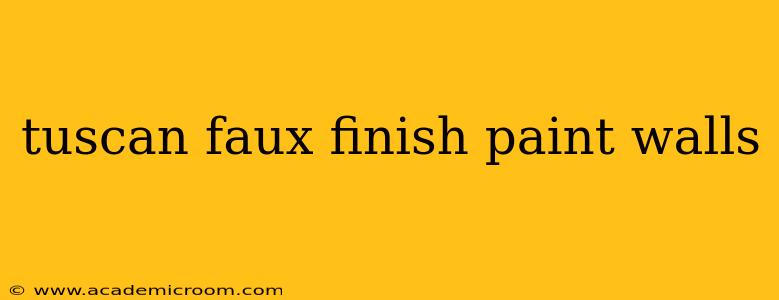The warm, earthy tones and textured surfaces of a Tuscan-style wall finish evoke the beauty of the Italian countryside. Creating this look in your home doesn't require a trip to Tuscany; with the right techniques and paints, you can achieve a stunning Tuscan faux finish on your walls. This guide will walk you through the process, covering everything from choosing the right colors to mastering the application techniques.
What is a Tuscan Faux Finish?
A Tuscan faux finish is a painting technique that imitates the look of aged plaster or stucco commonly found in Tuscan architecture. It’s characterized by its warm, earthy color palette, often incorporating muted yellows, oranges, reds, browns, and creams. The texture is key – it’s not a smooth, flat finish; instead, it features subtle variations in tone and texture, creating depth and visual interest. This effect is achieved through various techniques, including sponging, rag rolling, and dry brushing.
Choosing the Right Colors for Your Tuscan Faux Finish
The color palette is crucial for achieving an authentic Tuscan feel. Think of the sun-baked earth, aged terracotta, and warm hues found in the Tuscan landscape. Popular color choices include:
- Base Coats: Warm off-whites, creamy yellows, or light beige provide a perfect foundation.
- Highlight Colors: Burnt sienna, terracotta, ochre, and Venetian red add depth and warmth. Consider using a glaze or wash for a more translucent effect.
- Accent Colors: Deep browns, umber, or even a touch of deep green can be strategically used to highlight certain areas and create shadows.
How to Achieve a Tuscan Faux Finish: A Step-by-Step Guide
Before you begin, ensure your walls are properly prepared. This means cleaning, patching any holes or imperfections, and applying a primer to ensure even paint adhesion.
-
Apply the Base Coat: Use a high-quality interior paint in your chosen base color. Two coats are usually necessary for optimal coverage. Allow each coat to dry completely before proceeding.
-
Create the Texture: This is where the artistry comes in. There are several techniques to choose from:
- Sponging: Dip a sea sponge into your highlight color, then dab it lightly onto the wall, creating a mottled effect. Vary the pressure to achieve different levels of intensity.
- Rag Rolling: Using a crumpled rag, apply the highlight color in a rolling motion. This creates a more textured, uneven look.
- Dry Brushing: Using a dry brush with very little paint, lightly brush the highlight color onto the wall. This technique creates a subtle, almost antique effect.
-
Glazing (Optional): Applying a translucent glaze over the textured layers deepens the color and creates a more luminous effect.
-
Highlighting and Shadowing: Use darker accent colors to add shadows and depth in corners and crevices, further enhancing the three-dimensional look. A stippling brush can help create subtle variations.
-
Finishing Touches: Once the paint is completely dry, you can consider applying a protective sealant to preserve the finish and make it easier to clean.
What type of paint is best for a Tuscan faux finish?
High-quality interior latex paints are generally recommended for faux finishes. They provide excellent coverage, are easy to work with, and offer a durable finish. Consider using a paint specifically designed for glazing or washes for a more transparent and blended look.
Can I use a Tuscan faux finish in a small room?
Absolutely! A Tuscan faux finish can work beautifully in a small room, especially if you use lighter colors and focus on creating a sense of depth rather than overwhelming the space with too much texture.
How long does a Tuscan faux finish last?
With proper preparation and application, a well-executed Tuscan faux finish should last for several years. Regular cleaning with a damp cloth can help maintain its appearance.
How much does it cost to get a Tuscan faux finish done professionally?
The cost of hiring a professional to create a Tuscan faux finish varies greatly depending on the size of the area, the complexity of the design, and the painter's rates. It's best to get multiple quotes from local professionals.
By following these steps and using your creative flair, you can transform your walls into a stunning representation of Tuscan elegance, bringing the warmth and charm of Italy into your home. Remember, practice makes perfect – don't be afraid to experiment until you achieve the desired look.
